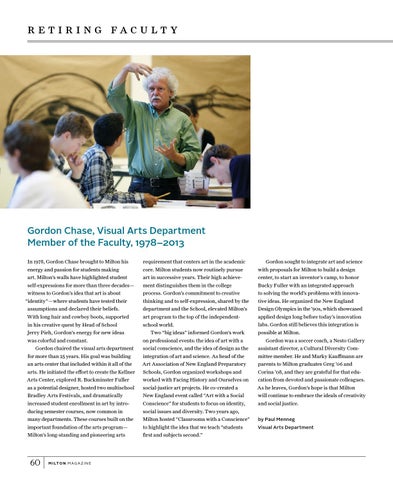r e t i r i n g fac u lt y
Gordon Chase, Visual Arts Department Member of the Faculty, 1978–2013 In 1978, Gordon Chase brought to Milton his
requirement that centers art in the academic
energy and passion for students making
core. Milton students now routinely pursue
Gordon sought to integrate art and science with proposals for Milton to build a design
art. Milton’s walls have highlighted student
art in successive years. Their high achieve-
center, to start an inventor’s camp, to honor
self-expressions for more than three decades —
ment distinguishes them in the college
Bucky Fuller with an integrated approach
witness to Gordon’s idea that art is about
process. Gordon’s commitment to creative
to solving the world’s problems with innova-
thinking and to self-expression, shared by the
tive ideas. He organized the New England Design Olympics in the ’90s, which showcased
“identity” — where students have tested their assumptions and declared their beliefs.
department and the School, elevated Milton’s
With long hair and cowboy boots, supported
art program to the top of the independent-
applied design long before today’s innovation
in his creative quest by Head of School
school world.
labs. Gordon still believes this integration is
Jerry Pieh, Gordon’s energy for new ideas was colorful and constant. Gordon chaired the visual arts department
Two “big ideas” informed Gordon’s work on professional events: the idea of art with a social conscience, and the idea of design as the
possible at Milton. Gordon was a soccer coach, a Nesto Gallery assistant director, a Cultural Diversity Com-
for more than 25 years. His goal was building
integration of art and science. As head of the
mittee member. He and Marky Kauffmann are
an arts center that included within it all of the
Art Association of New England Preparatory
parents to Milton graduates Greg ’06 and Corina ’08, and they are grateful for that edu-
arts. He initiated the effort to create the Kellner
Schools, Gordon organized workshops and
Arts Center, explored R. Buckminster Fuller
worked with Facing History and Ourselves on
cation from devoted and passionate colleagues.
as a potential designer, hosted two multischool
social-justice art projects. He co-created a
As he leaves, Gordon’s hope is that Milton
Bradley Arts Festivals, and dramatically
New England event called “Art with a Social
will continue to embrace the ideals of creativity and social justice.
increased student enrollment in art by intro-
Conscience” for students to focus on identity,
ducing semester courses, now common in
social issues and diversity. Two years ago,
many departments. These courses built on the
Milton hosted “Classrooms with a Conscience”
by Paul Menneg
important foundation of the arts program —
to highlight the idea that we teach “students
Visual Arts Department
Milton’s long-standing and pioneering arts
first and subjects second.”
60
mi lton magazi n e
